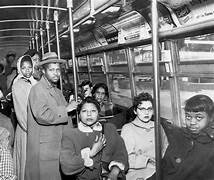In the annals of American history, 1956 was a pivotal year for civil rights. One of the most significant milestones in the ongoing struggle for racial equality was the end of segregated buses, a landmark event that unfolded against a backdrop of fervent activism and legal challenges. The year 1956 saw a watershed moment when the Supreme Court, through its ruling in the case of Browder v. Gayle, declared the segregation of buses in Montgomery, Alabama, unconstitutional. This decision effectively ended a longstanding practice of racial discrimination and marked a turning point in the broader civil rights movement. The story of segregated buses in the United States had deep historical roots. For decades, Jim Crow laws enforced racial segregation on public transportation, a glaring symbol of the systemic racism and inequality that plagued the country. In the South, African Americans were forced to sit at the back of the bus, a humiliating practice that represented the stark divisions and indignities they endured daily. But the seeds of change were sown years before 1956. The Montgomery Bus Boycott, sparked by the arrest of Rosa Parks on December 1, 1955, for refusing to give up her seat to a white man on a city bus, set the stage for the eventual dismantling of bus segregation. The African American community in Montgomery, led by civil rights leaders such as Dr. Martin Luther King Jr., organized a boycott, urging black citizens to avoid riding the city's buses until the segregation policy was reversed. This grassroots movement gained momentum, drawing national attention and support. The bus boycott lasted for 381 days, during which African Americans walked, carpooled, and rode in alternative means of transportation, enduring hardships and facing opposition from white supremacists. Their unwavering commitment to the cause demonstrated the power of nonviolent protest and the determination to achieve equality. This significant display of solidarity and resilience would ultimately prove to be instrumental in challenging the status quo. On December 20, 1956, the Supreme Court delivered its verdict in the Browder v. Gayle case, ruling that bus segregation was unconstitutional. This decision upheld the principles of the landmark Brown v. Board of Education ruling from 1954, which declared "separate but equal" facilities for black and white citizens to be inherently unequal. It was a clear and unequivocal victory for the civil rights movement. The end of segregated buses in Montgomery set a precedent for other cities in the South to follow suit. It was a pivotal moment that exemplified the power of peaceful resistance and demonstrated that the legal system could be a force for justice and change. In the wake of this ruling, more and more cities began to desegregate their public transportation systems, further dismantling the infrastructure of racial segregation. The events of 1956 were a turning point in the civil rights movement, providing hope and inspiration for activists across the country. The success of the Montgomery Bus Boycott and the Supreme Court's decision in Browder v. Gayle not only put an end to bus segregation but also galvanized the broader struggle for civil rights, leading to other significant milestones in the years that followed. In retrospect, 1956 was a year of triumph against the backdrop of adversity, a testament to the resilience and determination of those who fought for racial equality. The end of segregated buses was a crucial step towards dismantling institutionalized racism in the United States, and it set the stage for the continued push for civil rights and equality in the years that followed.
13 November 1956 U.S.A. – – Segregated Busses End
